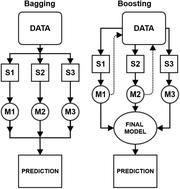当前位置:
X-MOL 学术
›
J. Anal. At. Spectrom.
›
论文详情
Our official English website, www.x-mol.net, welcomes your
feedback! (Note: you will need to create a separate account there.)
Comparison of machine learning techniques to optimize the analysis of plutonium surrogate material via a portable LIBS device
Journal of Analytical Atomic Spectrometry ( IF 3.1 ) Pub Date : 2020-12-8 , DOI: 10.1039/d0ja00435a Ashwin P. Rao 1, 2 , Phillip R. Jenkins 1, 2 , John D. Auxier II 2, 3, 4, 5, 6 , Michael B. Shattan 1, 2
Journal of Analytical Atomic Spectrometry ( IF 3.1 ) Pub Date : 2020-12-8 , DOI: 10.1039/d0ja00435a Ashwin P. Rao 1, 2 , Phillip R. Jenkins 1, 2 , John D. Auxier II 2, 3, 4, 5, 6 , Michael B. Shattan 1, 2
Affiliation

|
The utilization of machine learning techniques has become commonplace in the analysis of optical emission spectra. These methods are often limited to variants of principal components analysis (PCA), partial-least squares (PLS), and artificial neural networks (ANNs). A plethora of other techniques exist and are well established in the world of data science, yet are seldom investigated for their use in spectroscopic problems. In this study, machine learning techniques were used to analyze optical emission spectra of laser-induced plasma from ceria pellets doped with silicon in order to predict silicon content. A boosted regression ensemble model was created, and its predictive accuracy was compared to that of traditional PCA, PLS, and ANN regression models. Boosted regression tree ensembles yielded fits with R-squared (R2) values as high as 0.964 and mean-squared errors of prediction (MSEPs) as low as 0.074, providing the most accurate predictive model. Neural networks performed with slightly lower R2 values and higher MSEPs compared to the ensemble methods, thus indicating susceptibility to overfitting.
中文翻译:

通过便携式LIBS设备进行机器学习技术比较以优化the替代材料的分析
在光发射光谱分析中,机器学习技术的使用已变得司空见惯。这些方法通常限于主成分分析(PCA),偏最小二乘(PLS)和人工神经网络(ANN)的变体。存在大量其他技术,并且在数据科学领域中已经建立了许多其他技术,但很少研究它们在光谱学问题中的使用。在这项研究中,机器学习技术被用来分析掺杂硅的二氧化铈颗粒的激光诱导等离子体的光发射光谱,以预测硅含量。创建了增强的回归集成模型,并将其预测准确性与传统PCA,PLS和ANN回归模型进行了比较。增强的回归树集成产生与R的拟合平方(R 2)值高达0.964,预测均方误差(MSEP)则低至0.074,从而提供了最准确的预测模型。与集成方法相比,神经网络的R 2值略低,而MSEP较高,因此表明容易过拟合。
更新日期:2021-01-04
中文翻译:

通过便携式LIBS设备进行机器学习技术比较以优化the替代材料的分析
在光发射光谱分析中,机器学习技术的使用已变得司空见惯。这些方法通常限于主成分分析(PCA),偏最小二乘(PLS)和人工神经网络(ANN)的变体。存在大量其他技术,并且在数据科学领域中已经建立了许多其他技术,但很少研究它们在光谱学问题中的使用。在这项研究中,机器学习技术被用来分析掺杂硅的二氧化铈颗粒的激光诱导等离子体的光发射光谱,以预测硅含量。创建了增强的回归集成模型,并将其预测准确性与传统PCA,PLS和ANN回归模型进行了比较。增强的回归树集成产生与R的拟合平方(R 2)值高达0.964,预测均方误差(MSEP)则低至0.074,从而提供了最准确的预测模型。与集成方法相比,神经网络的R 2值略低,而MSEP较高,因此表明容易过拟合。











































 京公网安备 11010802027423号
京公网安备 11010802027423号